Do businesses understand their digital landscape?
VerifiedAdded on 2022/08/21
|16
|2854
|15
AI Summary
Contribute Materials
Your contribution can guide someone’s learning journey. Share your
documents today.
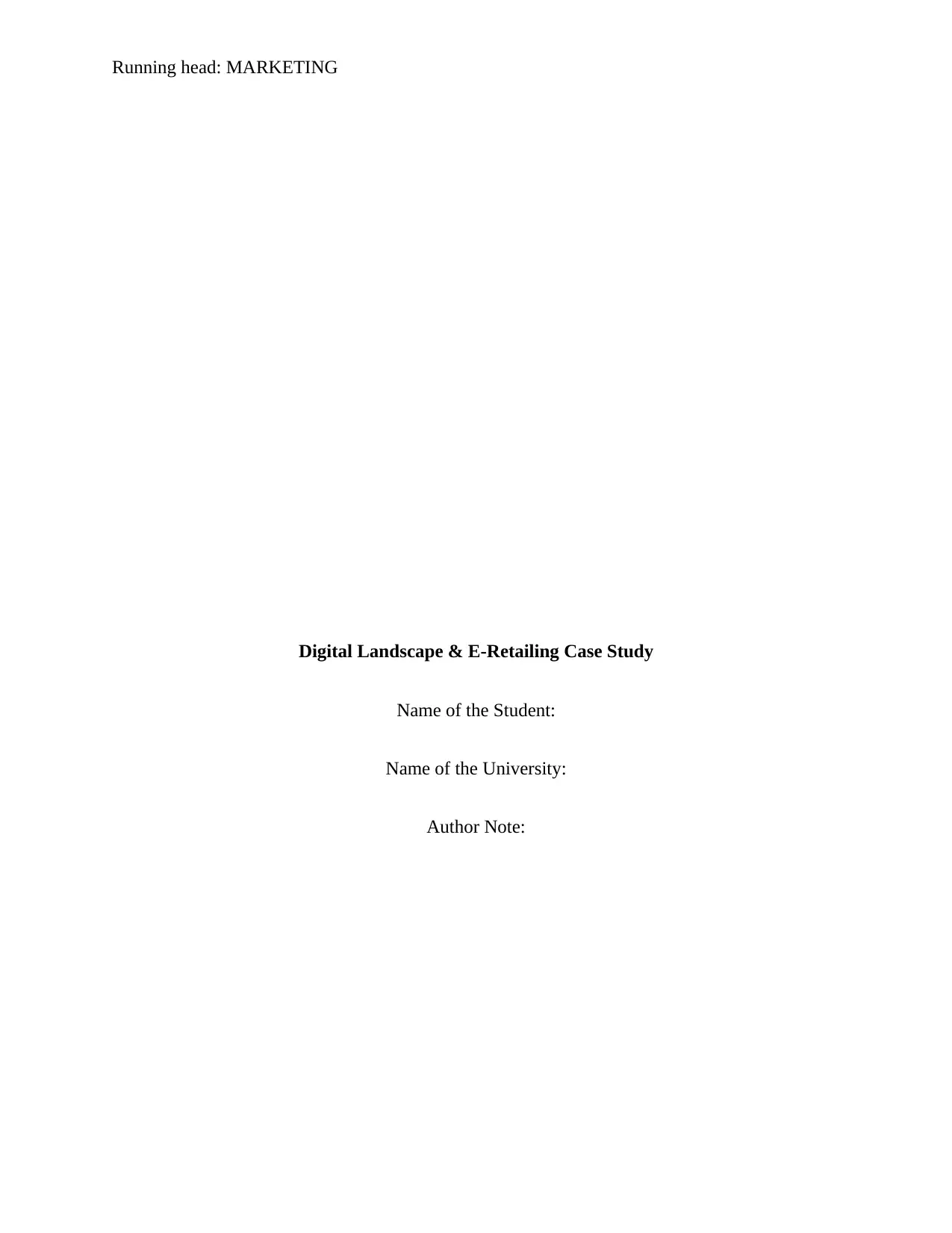
Running head: MARKETING
Digital Landscape & E-Retailing Case Study
Name of the Student:
Name of the University:
Author Note:
Digital Landscape & E-Retailing Case Study
Name of the Student:
Name of the University:
Author Note:
Secure Best Marks with AI Grader
Need help grading? Try our AI Grader for instant feedback on your assignments.
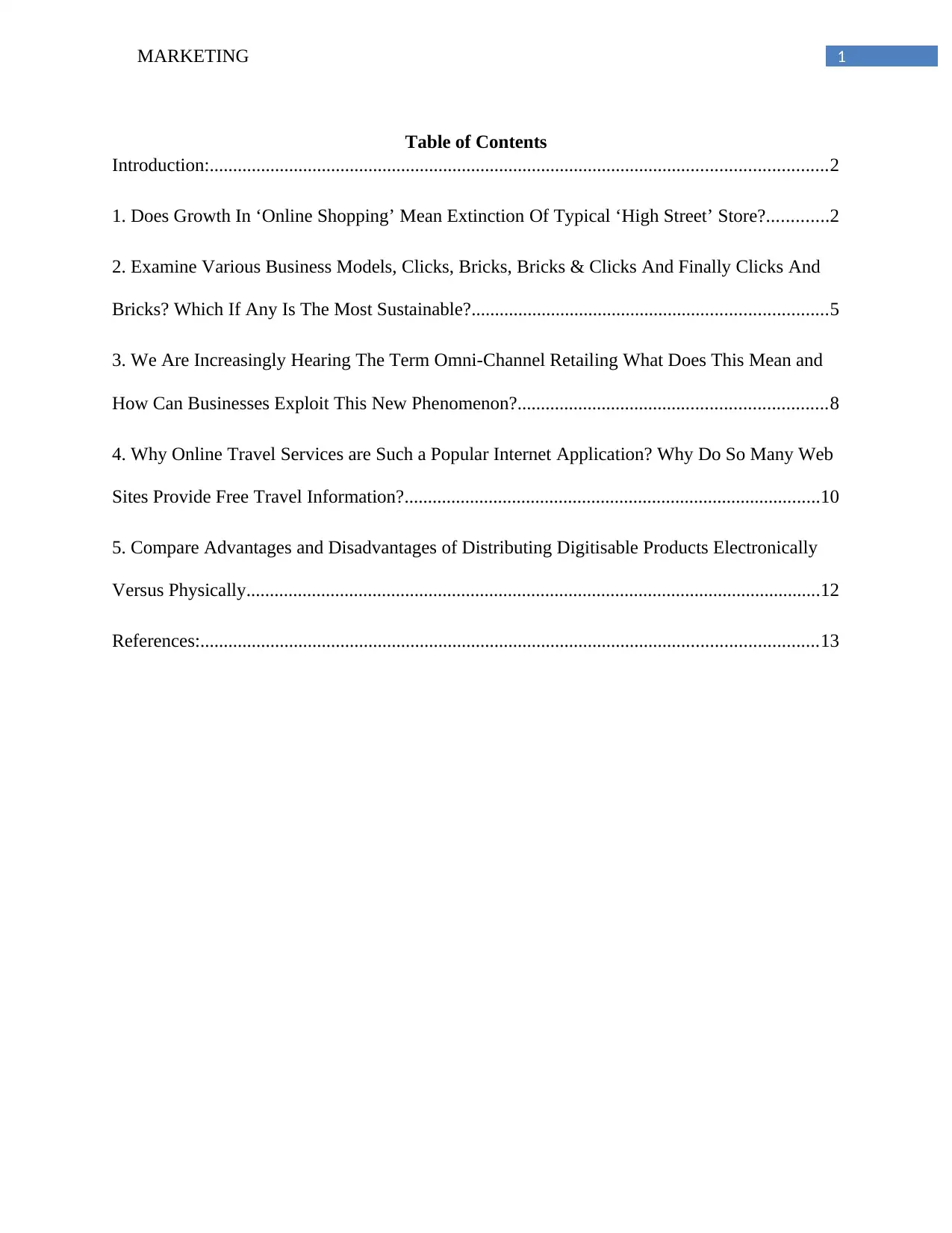
1MARKETING
Table of Contents
Introduction:....................................................................................................................................2
1. Does Growth In ‘Online Shopping’ Mean Extinction Of Typical ‘High Street’ Store?.............2
2. Examine Various Business Models, Clicks, Bricks, Bricks & Clicks And Finally Clicks And
Bricks? Which If Any Is The Most Sustainable?............................................................................5
3. We Are Increasingly Hearing The Term Omni-Channel Retailing What Does This Mean and
How Can Businesses Exploit This New Phenomenon?..................................................................8
4. Why Online Travel Services are Such a Popular Internet Application? Why Do So Many Web
Sites Provide Free Travel Information?.........................................................................................10
5. Compare Advantages and Disadvantages of Distributing Digitisable Products Electronically
Versus Physically...........................................................................................................................12
References:....................................................................................................................................13
Table of Contents
Introduction:....................................................................................................................................2
1. Does Growth In ‘Online Shopping’ Mean Extinction Of Typical ‘High Street’ Store?.............2
2. Examine Various Business Models, Clicks, Bricks, Bricks & Clicks And Finally Clicks And
Bricks? Which If Any Is The Most Sustainable?............................................................................5
3. We Are Increasingly Hearing The Term Omni-Channel Retailing What Does This Mean and
How Can Businesses Exploit This New Phenomenon?..................................................................8
4. Why Online Travel Services are Such a Popular Internet Application? Why Do So Many Web
Sites Provide Free Travel Information?.........................................................................................10
5. Compare Advantages and Disadvantages of Distributing Digitisable Products Electronically
Versus Physically...........................................................................................................................12
References:....................................................................................................................................13
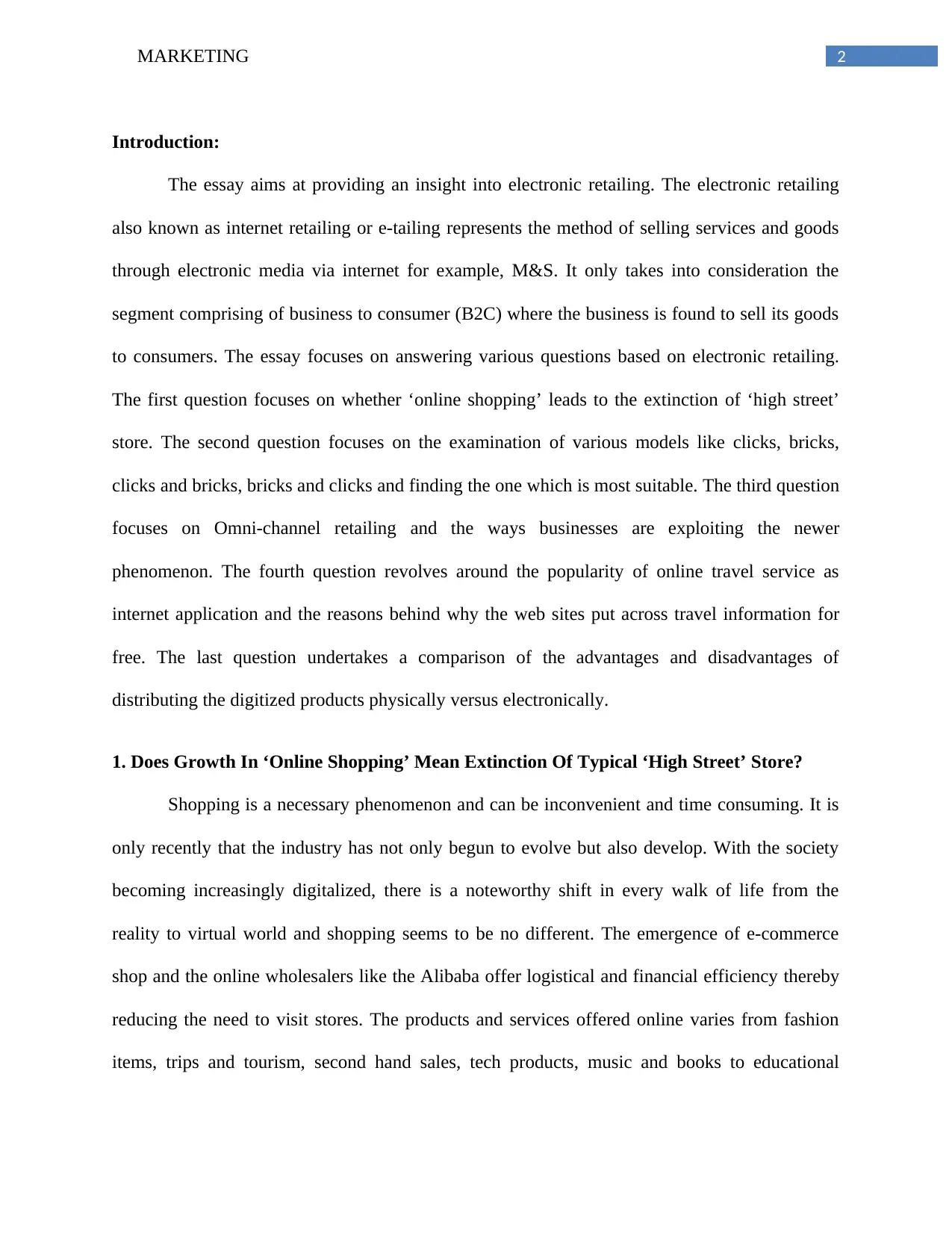
2MARKETING
Introduction:
The essay aims at providing an insight into electronic retailing. The electronic retailing
also known as internet retailing or e-tailing represents the method of selling services and goods
through electronic media via internet for example, M&S. It only takes into consideration the
segment comprising of business to consumer (B2C) where the business is found to sell its goods
to consumers. The essay focuses on answering various questions based on electronic retailing.
The first question focuses on whether ‘online shopping’ leads to the extinction of ‘high street’
store. The second question focuses on the examination of various models like clicks, bricks,
clicks and bricks, bricks and clicks and finding the one which is most suitable. The third question
focuses on Omni-channel retailing and the ways businesses are exploiting the newer
phenomenon. The fourth question revolves around the popularity of online travel service as
internet application and the reasons behind why the web sites put across travel information for
free. The last question undertakes a comparison of the advantages and disadvantages of
distributing the digitized products physically versus electronically.
1. Does Growth In ‘Online Shopping’ Mean Extinction Of Typical ‘High Street’ Store?
Shopping is a necessary phenomenon and can be inconvenient and time consuming. It is
only recently that the industry has not only begun to evolve but also develop. With the society
becoming increasingly digitalized, there is a noteworthy shift in every walk of life from the
reality to virtual world and shopping seems to be no different. The emergence of e-commerce
shop and the online wholesalers like the Alibaba offer logistical and financial efficiency thereby
reducing the need to visit stores. The products and services offered online varies from fashion
items, trips and tourism, second hand sales, tech products, music and books to educational
Introduction:
The essay aims at providing an insight into electronic retailing. The electronic retailing
also known as internet retailing or e-tailing represents the method of selling services and goods
through electronic media via internet for example, M&S. It only takes into consideration the
segment comprising of business to consumer (B2C) where the business is found to sell its goods
to consumers. The essay focuses on answering various questions based on electronic retailing.
The first question focuses on whether ‘online shopping’ leads to the extinction of ‘high street’
store. The second question focuses on the examination of various models like clicks, bricks,
clicks and bricks, bricks and clicks and finding the one which is most suitable. The third question
focuses on Omni-channel retailing and the ways businesses are exploiting the newer
phenomenon. The fourth question revolves around the popularity of online travel service as
internet application and the reasons behind why the web sites put across travel information for
free. The last question undertakes a comparison of the advantages and disadvantages of
distributing the digitized products physically versus electronically.
1. Does Growth In ‘Online Shopping’ Mean Extinction Of Typical ‘High Street’ Store?
Shopping is a necessary phenomenon and can be inconvenient and time consuming. It is
only recently that the industry has not only begun to evolve but also develop. With the society
becoming increasingly digitalized, there is a noteworthy shift in every walk of life from the
reality to virtual world and shopping seems to be no different. The emergence of e-commerce
shop and the online wholesalers like the Alibaba offer logistical and financial efficiency thereby
reducing the need to visit stores. The products and services offered online varies from fashion
items, trips and tourism, second hand sales, tech products, music and books to educational
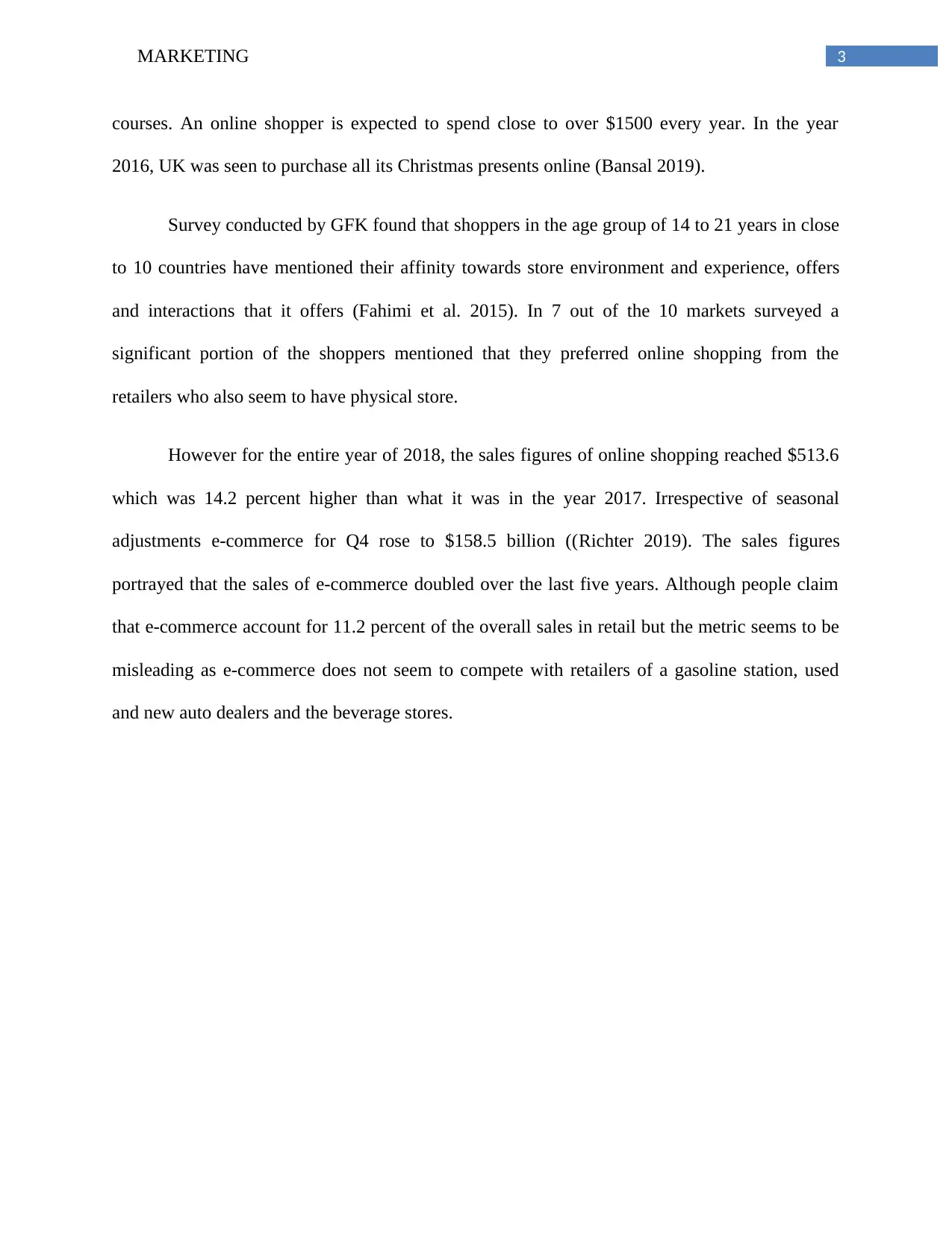
3MARKETING
courses. An online shopper is expected to spend close to over $1500 every year. In the year
2016, UK was seen to purchase all its Christmas presents online (Bansal 2019).
Survey conducted by GFK found that shoppers in the age group of 14 to 21 years in close
to 10 countries have mentioned their affinity towards store environment and experience, offers
and interactions that it offers (Fahimi et al. 2015). In 7 out of the 10 markets surveyed a
significant portion of the shoppers mentioned that they preferred online shopping from the
retailers who also seem to have physical store.
However for the entire year of 2018, the sales figures of online shopping reached $513.6
which was 14.2 percent higher than what it was in the year 2017. Irrespective of seasonal
adjustments e-commerce for Q4 rose to $158.5 billion ((Richter 2019). The sales figures
portrayed that the sales of e-commerce doubled over the last five years. Although people claim
that e-commerce account for 11.2 percent of the overall sales in retail but the metric seems to be
misleading as e-commerce does not seem to compete with retailers of a gasoline station, used
and new auto dealers and the beverage stores.
courses. An online shopper is expected to spend close to over $1500 every year. In the year
2016, UK was seen to purchase all its Christmas presents online (Bansal 2019).
Survey conducted by GFK found that shoppers in the age group of 14 to 21 years in close
to 10 countries have mentioned their affinity towards store environment and experience, offers
and interactions that it offers (Fahimi et al. 2015). In 7 out of the 10 markets surveyed a
significant portion of the shoppers mentioned that they preferred online shopping from the
retailers who also seem to have physical store.
However for the entire year of 2018, the sales figures of online shopping reached $513.6
which was 14.2 percent higher than what it was in the year 2017. Irrespective of seasonal
adjustments e-commerce for Q4 rose to $158.5 billion ((Richter 2019). The sales figures
portrayed that the sales of e-commerce doubled over the last five years. Although people claim
that e-commerce account for 11.2 percent of the overall sales in retail but the metric seems to be
misleading as e-commerce does not seem to compete with retailers of a gasoline station, used
and new auto dealers and the beverage stores.
Secure Best Marks with AI Grader
Need help grading? Try our AI Grader for instant feedback on your assignments.
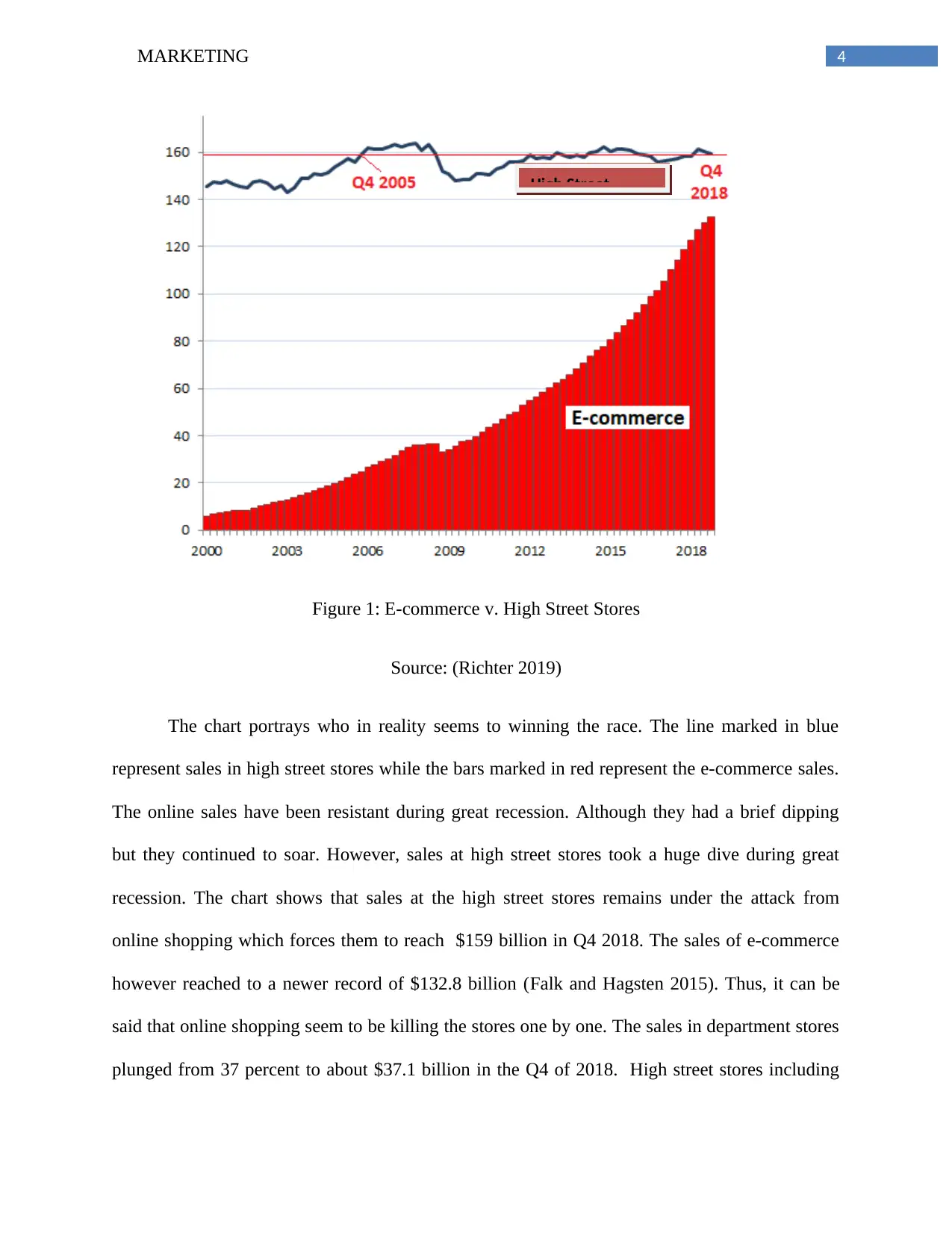
4MARKETING
Figure 1: E-commerce v. High Street Stores
Source: (Richter 2019)
The chart portrays who in reality seems to winning the race. The line marked in blue
represent sales in high street stores while the bars marked in red represent the e-commerce sales.
The online sales have been resistant during great recession. Although they had a brief dipping
but they continued to soar. However, sales at high street stores took a huge dive during great
recession. The chart shows that sales at the high street stores remains under the attack from
online shopping which forces them to reach $159 billion in Q4 2018. The sales of e-commerce
however reached to a newer record of $132.8 billion (Falk and Hagsten 2015). Thus, it can be
said that online shopping seem to be killing the stores one by one. The sales in department stores
plunged from 37 percent to about $37.1 billion in the Q4 of 2018. High street stores including
High Street
Figure 1: E-commerce v. High Street Stores
Source: (Richter 2019)
The chart portrays who in reality seems to winning the race. The line marked in blue
represent sales in high street stores while the bars marked in red represent the e-commerce sales.
The online sales have been resistant during great recession. Although they had a brief dipping
but they continued to soar. However, sales at high street stores took a huge dive during great
recession. The chart shows that sales at the high street stores remains under the attack from
online shopping which forces them to reach $159 billion in Q4 2018. The sales of e-commerce
however reached to a newer record of $132.8 billion (Falk and Hagsten 2015). Thus, it can be
said that online shopping seem to be killing the stores one by one. The sales in department stores
plunged from 37 percent to about $37.1 billion in the Q4 of 2018. High street stores including
High Street
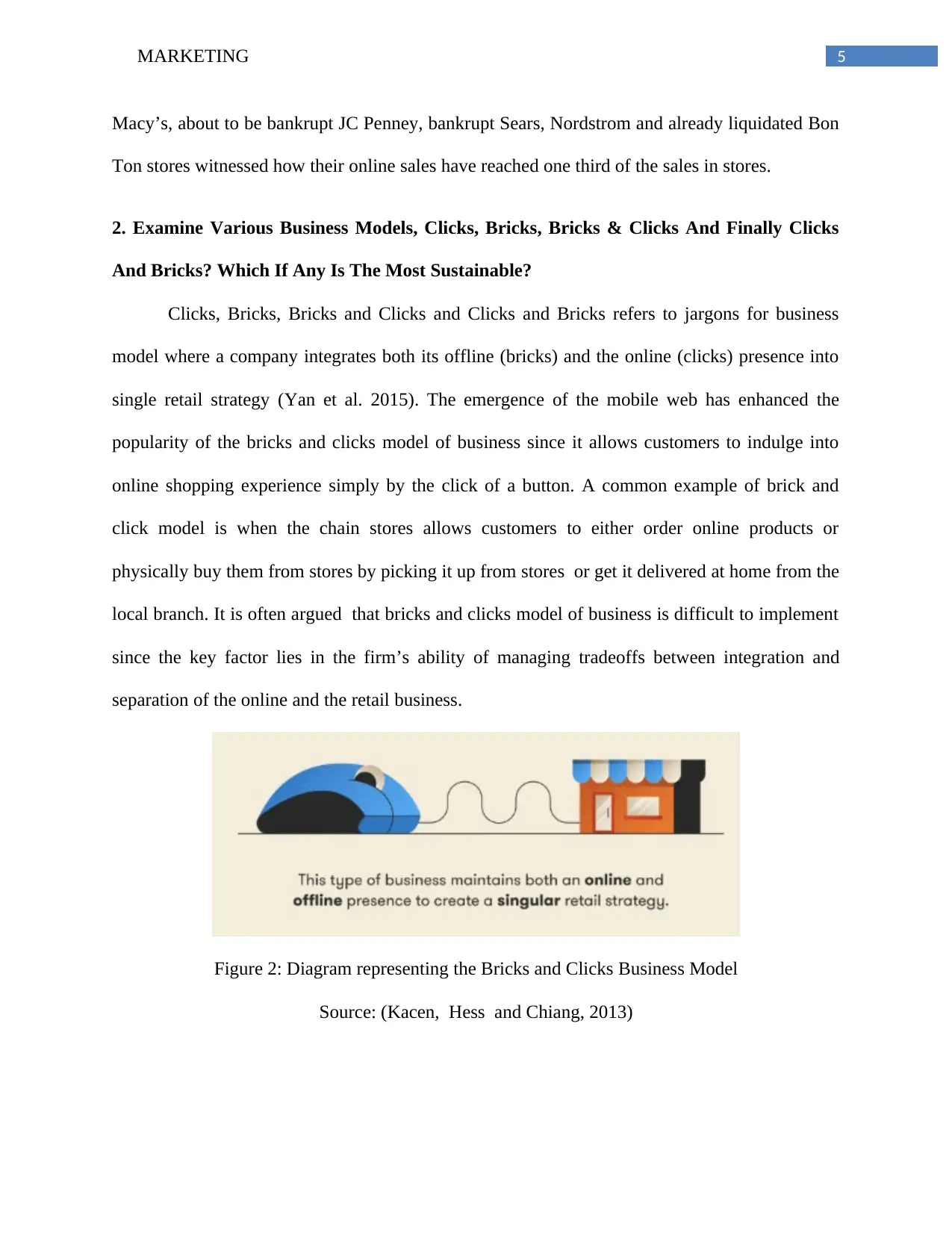
5MARKETING
Macy’s, about to be bankrupt JC Penney, bankrupt Sears, Nordstrom and already liquidated Bon
Ton stores witnessed how their online sales have reached one third of the sales in stores.
2. Examine Various Business Models, Clicks, Bricks, Bricks & Clicks And Finally Clicks
And Bricks? Which If Any Is The Most Sustainable?
Clicks, Bricks, Bricks and Clicks and Clicks and Bricks refers to jargons for business
model where a company integrates both its offline (bricks) and the online (clicks) presence into
single retail strategy (Yan et al. 2015). The emergence of the mobile web has enhanced the
popularity of the bricks and clicks model of business since it allows customers to indulge into
online shopping experience simply by the click of a button. A common example of brick and
click model is when the chain stores allows customers to either order online products or
physically buy them from stores by picking it up from stores or get it delivered at home from the
local branch. It is often argued that bricks and clicks model of business is difficult to implement
since the key factor lies in the firm’s ability of managing tradeoffs between integration and
separation of the online and the retail business.
Figure 2: Diagram representing the Bricks and Clicks Business Model
Source: (Kacen, Hess and Chiang, 2013)
Macy’s, about to be bankrupt JC Penney, bankrupt Sears, Nordstrom and already liquidated Bon
Ton stores witnessed how their online sales have reached one third of the sales in stores.
2. Examine Various Business Models, Clicks, Bricks, Bricks & Clicks And Finally Clicks
And Bricks? Which If Any Is The Most Sustainable?
Clicks, Bricks, Bricks and Clicks and Clicks and Bricks refers to jargons for business
model where a company integrates both its offline (bricks) and the online (clicks) presence into
single retail strategy (Yan et al. 2015). The emergence of the mobile web has enhanced the
popularity of the bricks and clicks model of business since it allows customers to indulge into
online shopping experience simply by the click of a button. A common example of brick and
click model is when the chain stores allows customers to either order online products or
physically buy them from stores by picking it up from stores or get it delivered at home from the
local branch. It is often argued that bricks and clicks model of business is difficult to implement
since the key factor lies in the firm’s ability of managing tradeoffs between integration and
separation of the online and the retail business.
Figure 2: Diagram representing the Bricks and Clicks Business Model
Source: (Kacen, Hess and Chiang, 2013)
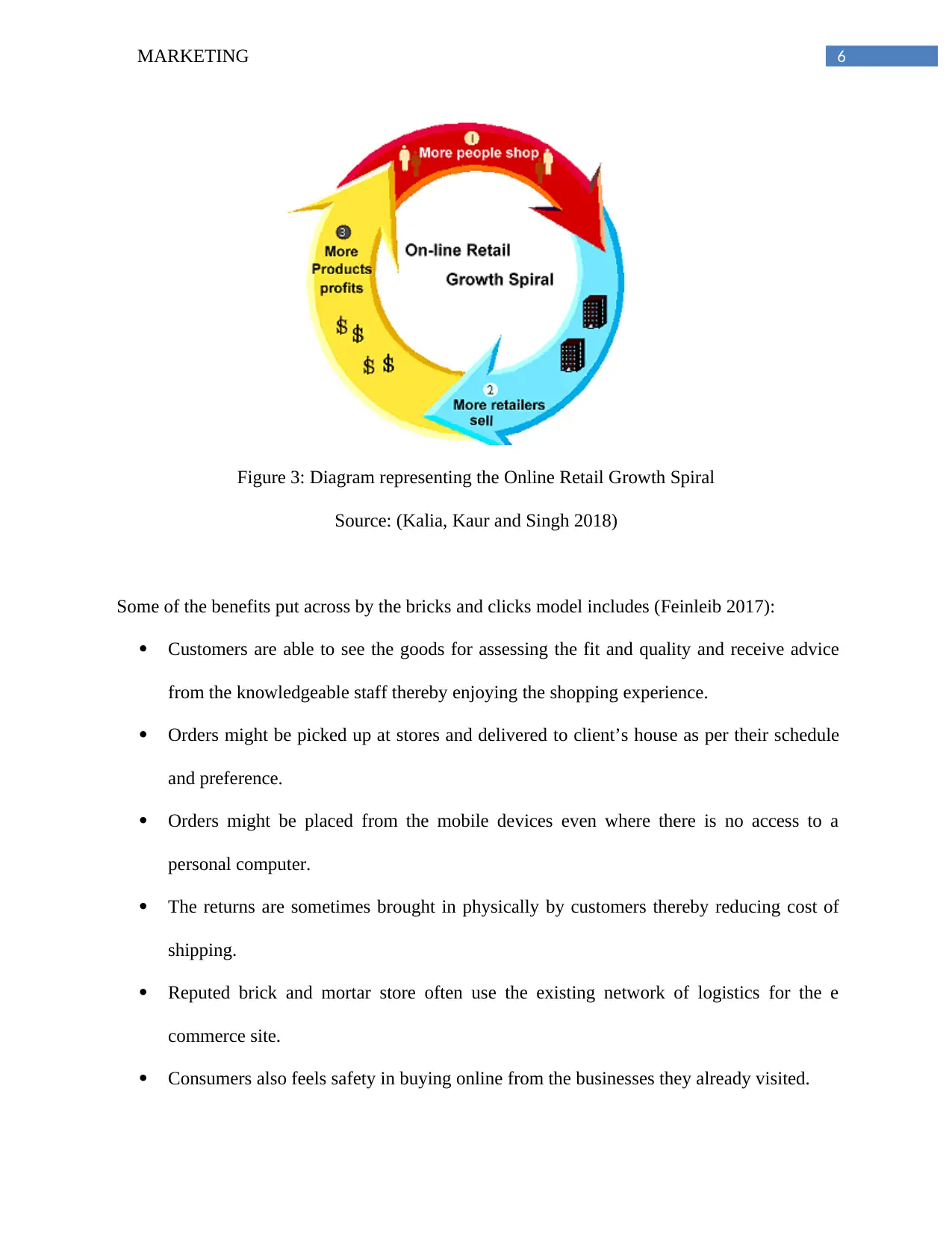
6MARKETING
Figure 3: Diagram representing the Online Retail Growth Spiral
Source: (Kalia, Kaur and Singh 2018)
Some of the benefits put across by the bricks and clicks model includes (Feinleib 2017):
Customers are able to see the goods for assessing the fit and quality and receive advice
from the knowledgeable staff thereby enjoying the shopping experience.
Orders might be picked up at stores and delivered to client’s house as per their schedule
and preference.
Orders might be placed from the mobile devices even where there is no access to a
personal computer.
The returns are sometimes brought in physically by customers thereby reducing cost of
shipping.
Reputed brick and mortar store often use the existing network of logistics for the e
commerce site.
Consumers also feels safety in buying online from the businesses they already visited.
Figure 3: Diagram representing the Online Retail Growth Spiral
Source: (Kalia, Kaur and Singh 2018)
Some of the benefits put across by the bricks and clicks model includes (Feinleib 2017):
Customers are able to see the goods for assessing the fit and quality and receive advice
from the knowledgeable staff thereby enjoying the shopping experience.
Orders might be picked up at stores and delivered to client’s house as per their schedule
and preference.
Orders might be placed from the mobile devices even where there is no access to a
personal computer.
The returns are sometimes brought in physically by customers thereby reducing cost of
shipping.
Reputed brick and mortar store often use the existing network of logistics for the e
commerce site.
Consumers also feels safety in buying online from the businesses they already visited.
Paraphrase This Document
Need a fresh take? Get an instant paraphrase of this document with our AI Paraphraser
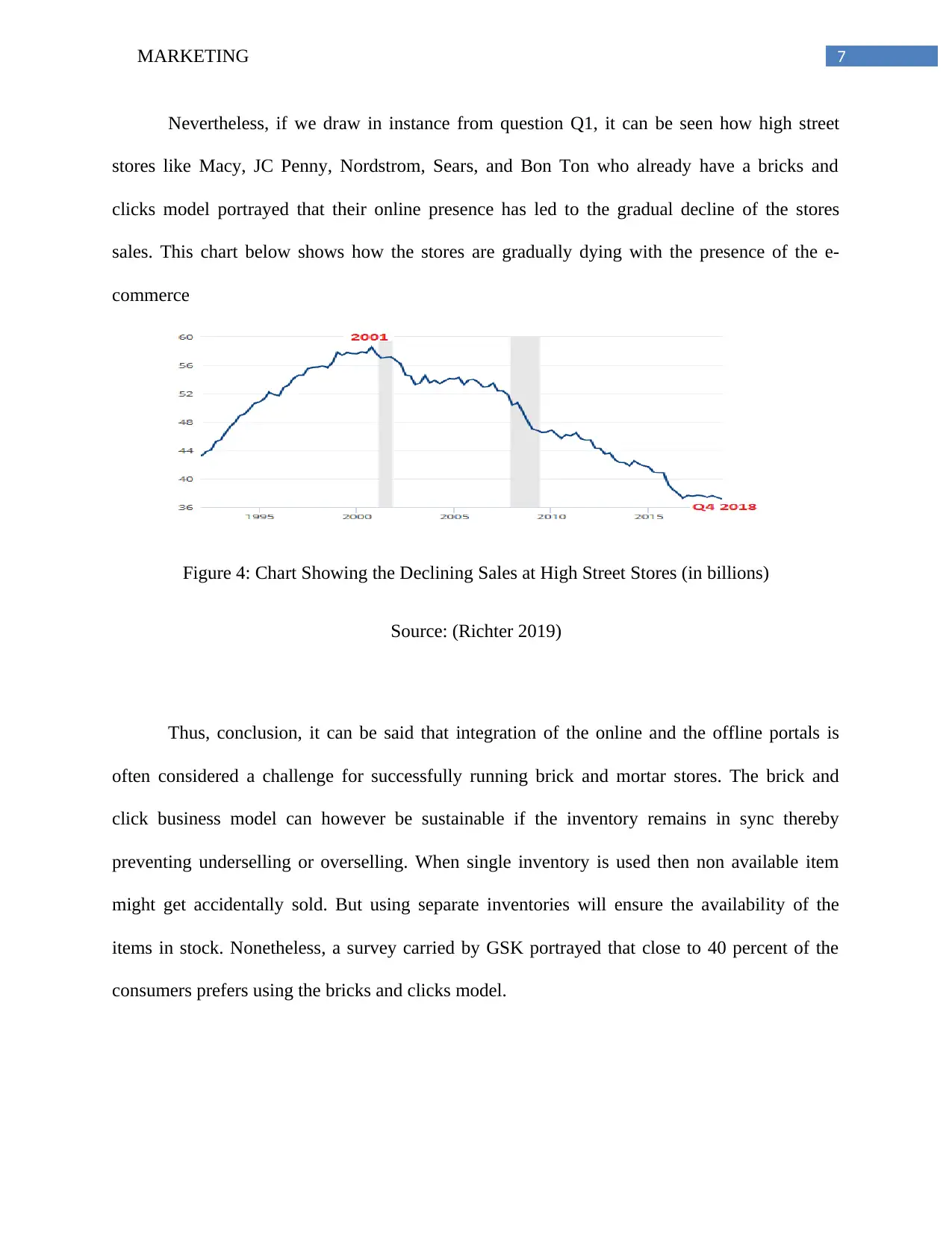
7MARKETING
Nevertheless, if we draw in instance from question Q1, it can be seen how high street
stores like Macy, JC Penny, Nordstrom, Sears, and Bon Ton who already have a bricks and
clicks model portrayed that their online presence has led to the gradual decline of the stores
sales. This chart below shows how the stores are gradually dying with the presence of the e-
commerce
Figure 4: Chart Showing the Declining Sales at High Street Stores (in billions)
Source: (Richter 2019)
Thus, conclusion, it can be said that integration of the online and the offline portals is
often considered a challenge for successfully running brick and mortar stores. The brick and
click business model can however be sustainable if the inventory remains in sync thereby
preventing underselling or overselling. When single inventory is used then non available item
might get accidentally sold. But using separate inventories will ensure the availability of the
items in stock. Nonetheless, a survey carried by GSK portrayed that close to 40 percent of the
consumers prefers using the bricks and clicks model.
Nevertheless, if we draw in instance from question Q1, it can be seen how high street
stores like Macy, JC Penny, Nordstrom, Sears, and Bon Ton who already have a bricks and
clicks model portrayed that their online presence has led to the gradual decline of the stores
sales. This chart below shows how the stores are gradually dying with the presence of the e-
commerce
Figure 4: Chart Showing the Declining Sales at High Street Stores (in billions)
Source: (Richter 2019)
Thus, conclusion, it can be said that integration of the online and the offline portals is
often considered a challenge for successfully running brick and mortar stores. The brick and
click business model can however be sustainable if the inventory remains in sync thereby
preventing underselling or overselling. When single inventory is used then non available item
might get accidentally sold. But using separate inventories will ensure the availability of the
items in stock. Nonetheless, a survey carried by GSK portrayed that close to 40 percent of the
consumers prefers using the bricks and clicks model.
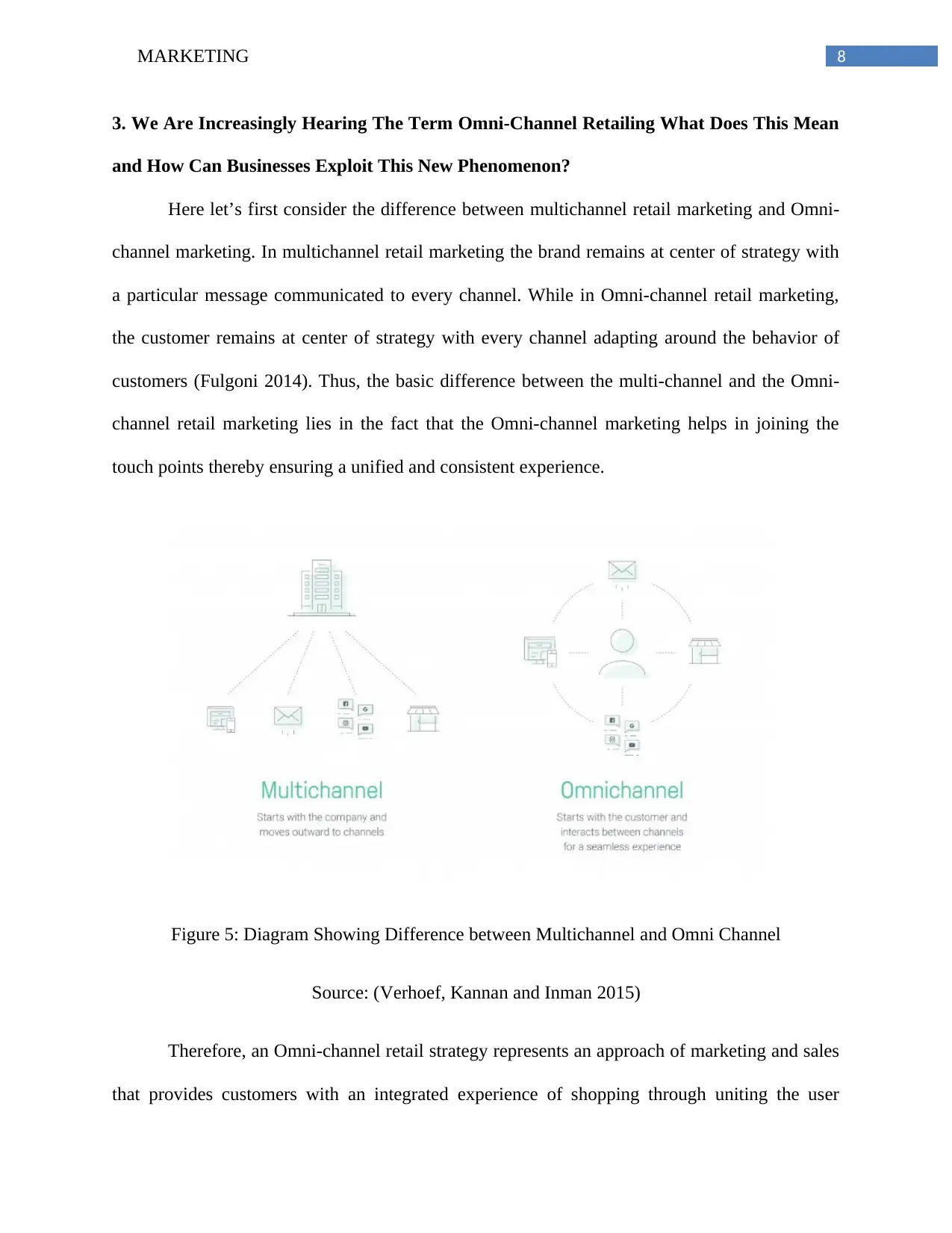
8MARKETING
3. We Are Increasingly Hearing The Term Omni-Channel Retailing What Does This Mean
and How Can Businesses Exploit This New Phenomenon?
Here let’s first consider the difference between multichannel retail marketing and Omni-
channel marketing. In multichannel retail marketing the brand remains at center of strategy with
a particular message communicated to every channel. While in Omni-channel retail marketing,
the customer remains at center of strategy with every channel adapting around the behavior of
customers (Fulgoni 2014). Thus, the basic difference between the multi-channel and the Omni-
channel retail marketing lies in the fact that the Omni-channel marketing helps in joining the
touch points thereby ensuring a unified and consistent experience.
Figure 5: Diagram Showing Difference between Multichannel and Omni Channel
Source: (Verhoef, Kannan and Inman 2015)
Therefore, an Omni-channel retail strategy represents an approach of marketing and sales
that provides customers with an integrated experience of shopping through uniting the user
3. We Are Increasingly Hearing The Term Omni-Channel Retailing What Does This Mean
and How Can Businesses Exploit This New Phenomenon?
Here let’s first consider the difference between multichannel retail marketing and Omni-
channel marketing. In multichannel retail marketing the brand remains at center of strategy with
a particular message communicated to every channel. While in Omni-channel retail marketing,
the customer remains at center of strategy with every channel adapting around the behavior of
customers (Fulgoni 2014). Thus, the basic difference between the multi-channel and the Omni-
channel retail marketing lies in the fact that the Omni-channel marketing helps in joining the
touch points thereby ensuring a unified and consistent experience.
Figure 5: Diagram Showing Difference between Multichannel and Omni Channel
Source: (Verhoef, Kannan and Inman 2015)
Therefore, an Omni-channel retail strategy represents an approach of marketing and sales
that provides customers with an integrated experience of shopping through uniting the user
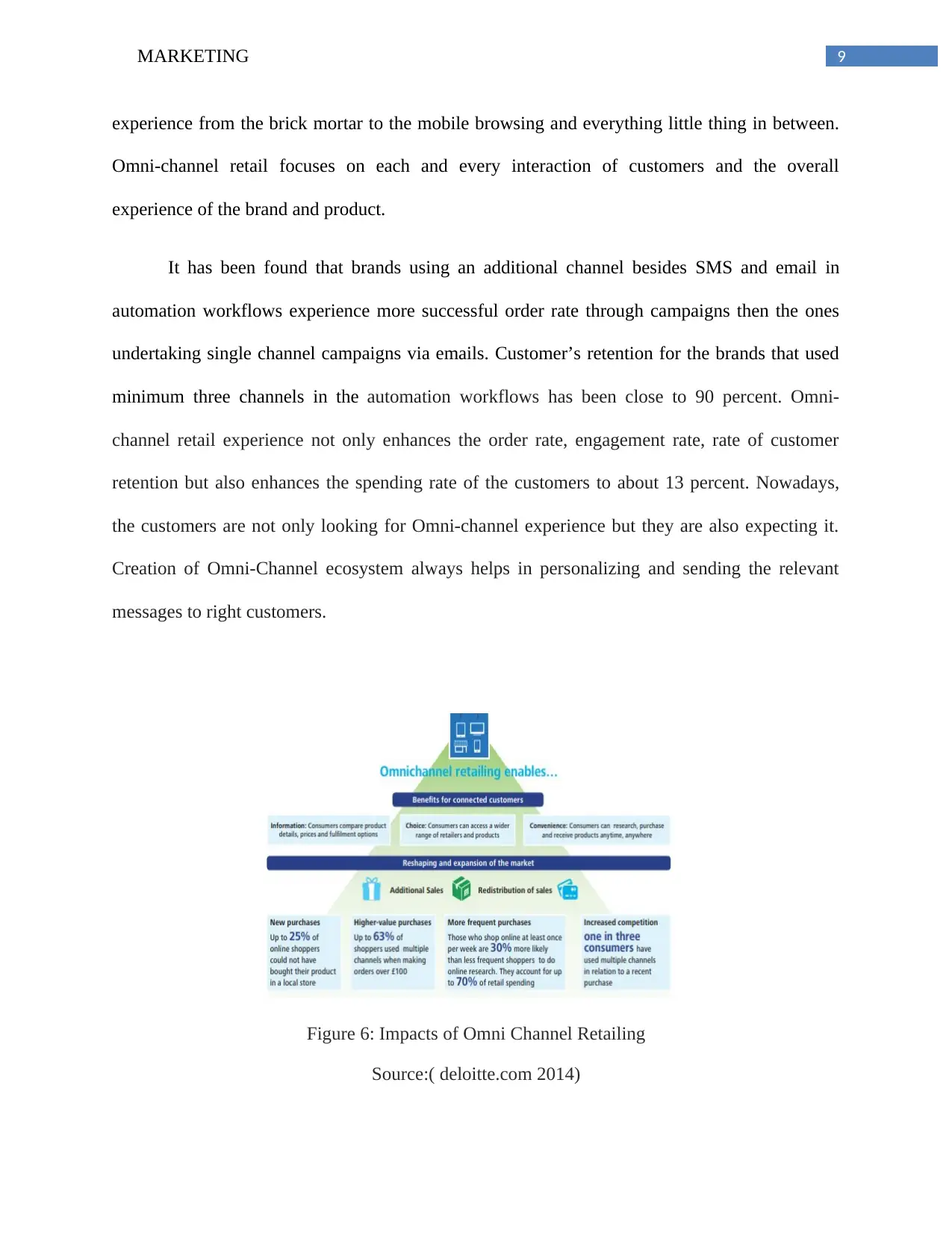
9MARKETING
experience from the brick mortar to the mobile browsing and everything little thing in between.
Omni-channel retail focuses on each and every interaction of customers and the overall
experience of the brand and product.
It has been found that brands using an additional channel besides SMS and email in
automation workflows experience more successful order rate through campaigns then the ones
undertaking single channel campaigns via emails. Customer’s retention for the brands that used
minimum three channels in the automation workflows has been close to 90 percent. Omni-
channel retail experience not only enhances the order rate, engagement rate, rate of customer
retention but also enhances the spending rate of the customers to about 13 percent. Nowadays,
the customers are not only looking for Omni-channel experience but they are also expecting it.
Creation of Omni-Channel ecosystem always helps in personalizing and sending the relevant
messages to right customers.
Figure 6: Impacts of Omni Channel Retailing
Source:( deloitte.com 2014)
experience from the brick mortar to the mobile browsing and everything little thing in between.
Omni-channel retail focuses on each and every interaction of customers and the overall
experience of the brand and product.
It has been found that brands using an additional channel besides SMS and email in
automation workflows experience more successful order rate through campaigns then the ones
undertaking single channel campaigns via emails. Customer’s retention for the brands that used
minimum three channels in the automation workflows has been close to 90 percent. Omni-
channel retail experience not only enhances the order rate, engagement rate, rate of customer
retention but also enhances the spending rate of the customers to about 13 percent. Nowadays,
the customers are not only looking for Omni-channel experience but they are also expecting it.
Creation of Omni-Channel ecosystem always helps in personalizing and sending the relevant
messages to right customers.
Figure 6: Impacts of Omni Channel Retailing
Source:( deloitte.com 2014)
Secure Best Marks with AI Grader
Need help grading? Try our AI Grader for instant feedback on your assignments.
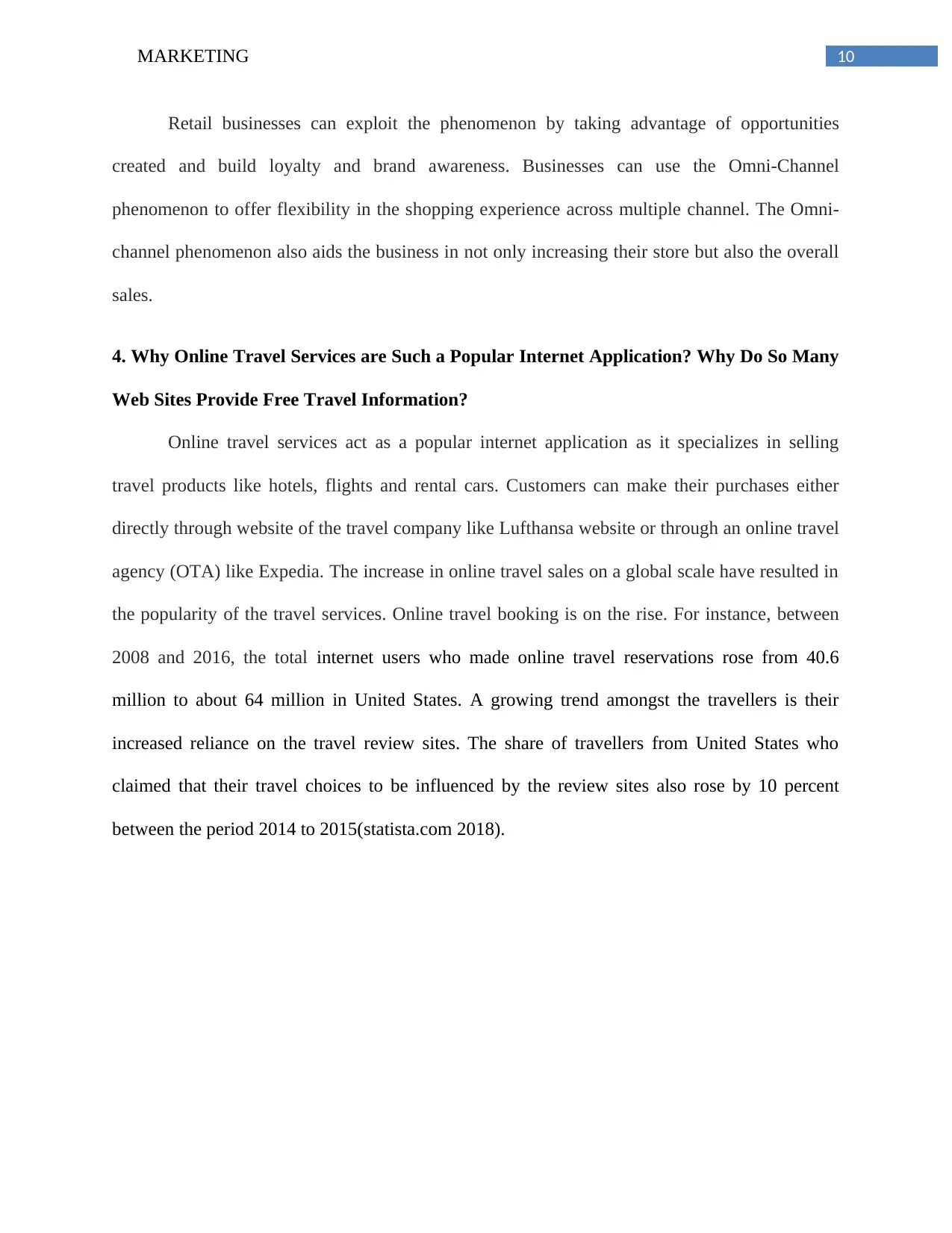
10MARKETING
Retail businesses can exploit the phenomenon by taking advantage of opportunities
created and build loyalty and brand awareness. Businesses can use the Omni-Channel
phenomenon to offer flexibility in the shopping experience across multiple channel. The Omni-
channel phenomenon also aids the business in not only increasing their store but also the overall
sales.
4. Why Online Travel Services are Such a Popular Internet Application? Why Do So Many
Web Sites Provide Free Travel Information?
Online travel services act as a popular internet application as it specializes in selling
travel products like hotels, flights and rental cars. Customers can make their purchases either
directly through website of the travel company like Lufthansa website or through an online travel
agency (OTA) like Expedia. The increase in online travel sales on a global scale have resulted in
the popularity of the travel services. Online travel booking is on the rise. For instance, between
2008 and 2016, the total internet users who made online travel reservations rose from 40.6
million to about 64 million in United States. A growing trend amongst the travellers is their
increased reliance on the travel review sites. The share of travellers from United States who
claimed that their travel choices to be influenced by the review sites also rose by 10 percent
between the period 2014 to 2015(statista.com 2018).
Retail businesses can exploit the phenomenon by taking advantage of opportunities
created and build loyalty and brand awareness. Businesses can use the Omni-Channel
phenomenon to offer flexibility in the shopping experience across multiple channel. The Omni-
channel phenomenon also aids the business in not only increasing their store but also the overall
sales.
4. Why Online Travel Services are Such a Popular Internet Application? Why Do So Many
Web Sites Provide Free Travel Information?
Online travel services act as a popular internet application as it specializes in selling
travel products like hotels, flights and rental cars. Customers can make their purchases either
directly through website of the travel company like Lufthansa website or through an online travel
agency (OTA) like Expedia. The increase in online travel sales on a global scale have resulted in
the popularity of the travel services. Online travel booking is on the rise. For instance, between
2008 and 2016, the total internet users who made online travel reservations rose from 40.6
million to about 64 million in United States. A growing trend amongst the travellers is their
increased reliance on the travel review sites. The share of travellers from United States who
claimed that their travel choices to be influenced by the review sites also rose by 10 percent
between the period 2014 to 2015(statista.com 2018).
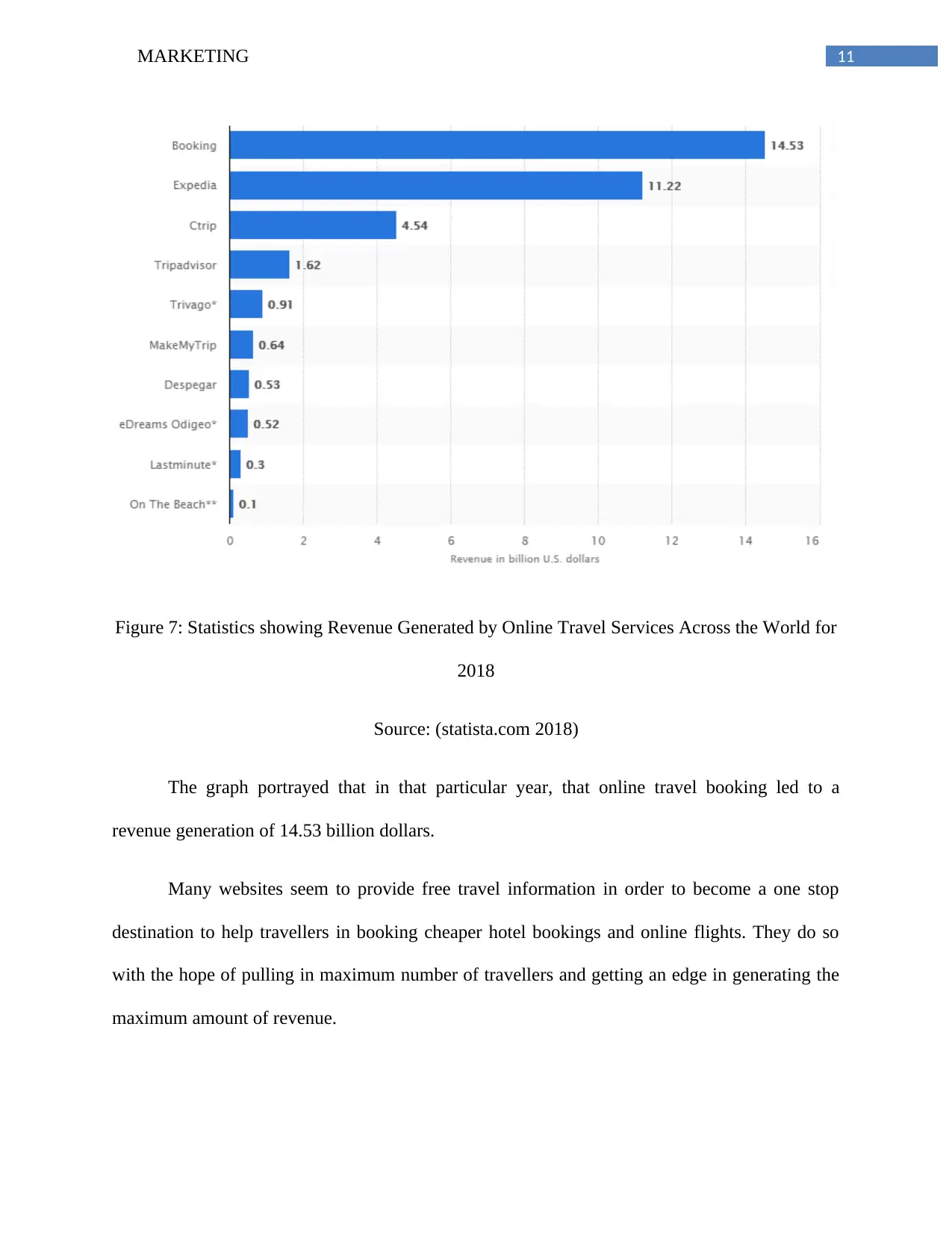
11MARKETING
Figure 7: Statistics showing Revenue Generated by Online Travel Services Across the World for
2018
Source: (statista.com 2018)
The graph portrayed that in that particular year, that online travel booking led to a
revenue generation of 14.53 billion dollars.
Many websites seem to provide free travel information in order to become a one stop
destination to help travellers in booking cheaper hotel bookings and online flights. They do so
with the hope of pulling in maximum number of travellers and getting an edge in generating the
maximum amount of revenue.
Figure 7: Statistics showing Revenue Generated by Online Travel Services Across the World for
2018
Source: (statista.com 2018)
The graph portrayed that in that particular year, that online travel booking led to a
revenue generation of 14.53 billion dollars.
Many websites seem to provide free travel information in order to become a one stop
destination to help travellers in booking cheaper hotel bookings and online flights. They do so
with the hope of pulling in maximum number of travellers and getting an edge in generating the
maximum amount of revenue.
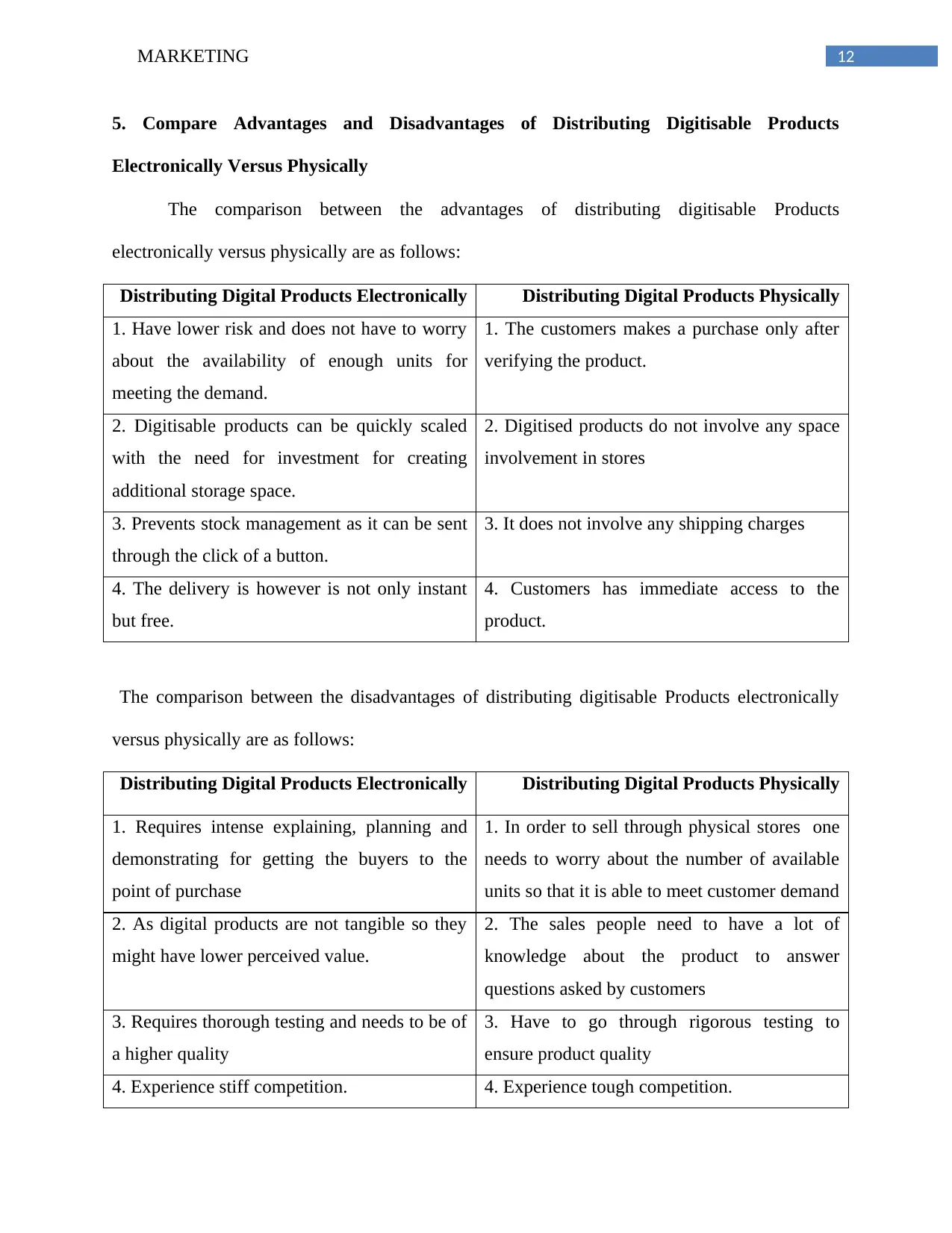
12MARKETING
5. Compare Advantages and Disadvantages of Distributing Digitisable Products
Electronically Versus Physically
The comparison between the advantages of distributing digitisable Products
electronically versus physically are as follows:
Distributing Digital Products Electronically Distributing Digital Products Physically
1. Have lower risk and does not have to worry
about the availability of enough units for
meeting the demand.
1. The customers makes a purchase only after
verifying the product.
2. Digitisable products can be quickly scaled
with the need for investment for creating
additional storage space.
2. Digitised products do not involve any space
involvement in stores
3. Prevents stock management as it can be sent
through the click of a button.
3. It does not involve any shipping charges
4. The delivery is however is not only instant
but free.
4. Customers has immediate access to the
product.
The comparison between the disadvantages of distributing digitisable Products electronically
versus physically are as follows:
Distributing Digital Products Electronically Distributing Digital Products Physically
1. Requires intense explaining, planning and
demonstrating for getting the buyers to the
point of purchase
1. In order to sell through physical stores one
needs to worry about the number of available
units so that it is able to meet customer demand
2. As digital products are not tangible so they
might have lower perceived value.
2. The sales people need to have a lot of
knowledge about the product to answer
questions asked by customers
3. Requires thorough testing and needs to be of
a higher quality
3. Have to go through rigorous testing to
ensure product quality
4. Experience stiff competition. 4. Experience tough competition.
5. Compare Advantages and Disadvantages of Distributing Digitisable Products
Electronically Versus Physically
The comparison between the advantages of distributing digitisable Products
electronically versus physically are as follows:
Distributing Digital Products Electronically Distributing Digital Products Physically
1. Have lower risk and does not have to worry
about the availability of enough units for
meeting the demand.
1. The customers makes a purchase only after
verifying the product.
2. Digitisable products can be quickly scaled
with the need for investment for creating
additional storage space.
2. Digitised products do not involve any space
involvement in stores
3. Prevents stock management as it can be sent
through the click of a button.
3. It does not involve any shipping charges
4. The delivery is however is not only instant
but free.
4. Customers has immediate access to the
product.
The comparison between the disadvantages of distributing digitisable Products electronically
versus physically are as follows:
Distributing Digital Products Electronically Distributing Digital Products Physically
1. Requires intense explaining, planning and
demonstrating for getting the buyers to the
point of purchase
1. In order to sell through physical stores one
needs to worry about the number of available
units so that it is able to meet customer demand
2. As digital products are not tangible so they
might have lower perceived value.
2. The sales people need to have a lot of
knowledge about the product to answer
questions asked by customers
3. Requires thorough testing and needs to be of
a higher quality
3. Have to go through rigorous testing to
ensure product quality
4. Experience stiff competition. 4. Experience tough competition.
Paraphrase This Document
Need a fresh take? Get an instant paraphrase of this document with our AI Paraphraser
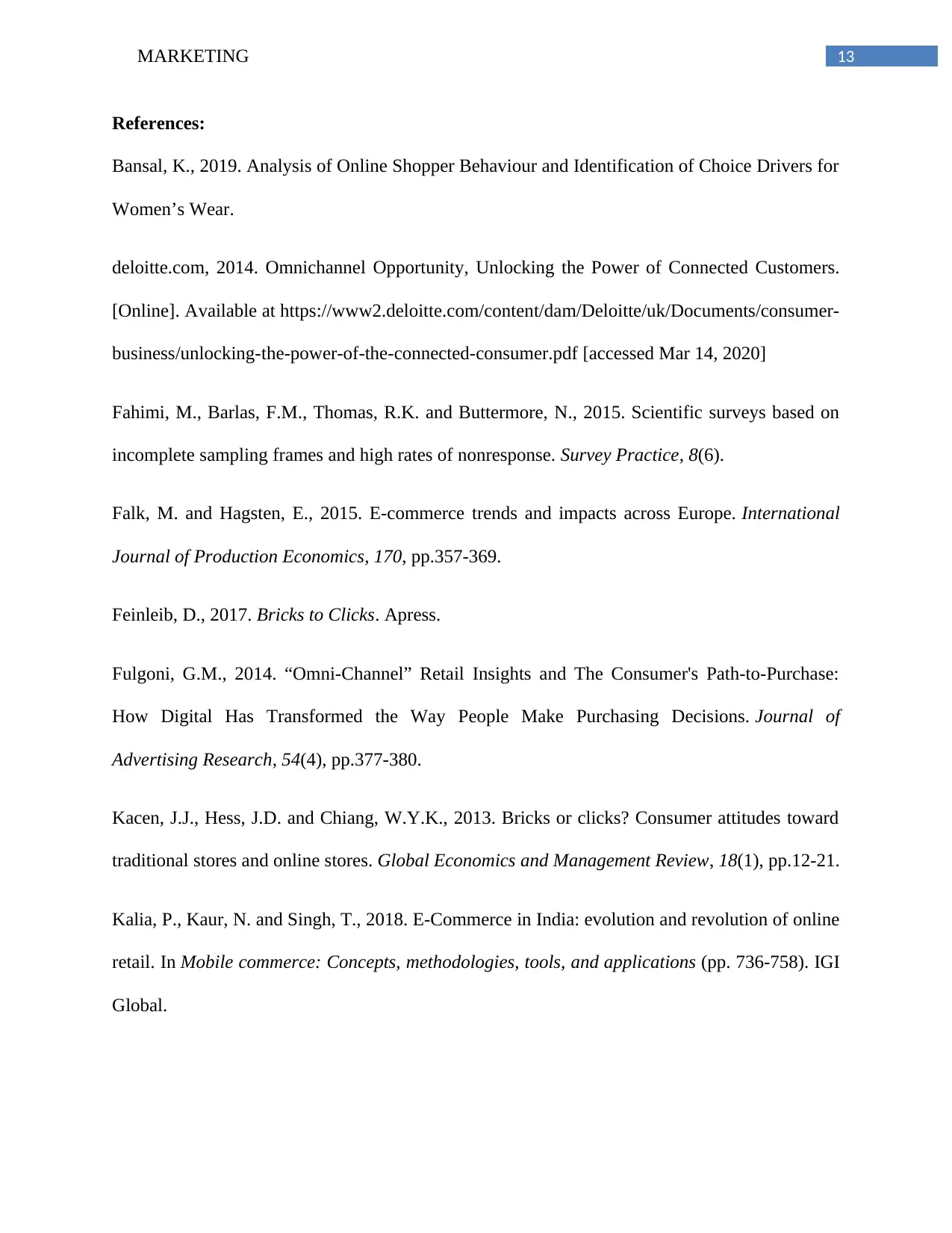
13MARKETING
References:
Bansal, K., 2019. Analysis of Online Shopper Behaviour and Identification of Choice Drivers for
Women’s Wear.
deloitte.com, 2014. Omnichannel Opportunity, Unlocking the Power of Connected Customers.
[Online]. Available at https://www2.deloitte.com/content/dam/Deloitte/uk/Documents/consumer-
business/unlocking-the-power-of-the-connected-consumer.pdf [accessed Mar 14, 2020]
Fahimi, M., Barlas, F.M., Thomas, R.K. and Buttermore, N., 2015. Scientific surveys based on
incomplete sampling frames and high rates of nonresponse. Survey Practice, 8(6).
Falk, M. and Hagsten, E., 2015. E-commerce trends and impacts across Europe. International
Journal of Production Economics, 170, pp.357-369.
Feinleib, D., 2017. Bricks to Clicks. Apress.
Fulgoni, G.M., 2014. “Omni-Channel” Retail Insights and The Consumer's Path-to-Purchase:
How Digital Has Transformed the Way People Make Purchasing Decisions. Journal of
Advertising Research, 54(4), pp.377-380.
Kacen, J.J., Hess, J.D. and Chiang, W.Y.K., 2013. Bricks or clicks? Consumer attitudes toward
traditional stores and online stores. Global Economics and Management Review, 18(1), pp.12-21.
Kalia, P., Kaur, N. and Singh, T., 2018. E-Commerce in India: evolution and revolution of online
retail. In Mobile commerce: Concepts, methodologies, tools, and applications (pp. 736-758). IGI
Global.
References:
Bansal, K., 2019. Analysis of Online Shopper Behaviour and Identification of Choice Drivers for
Women’s Wear.
deloitte.com, 2014. Omnichannel Opportunity, Unlocking the Power of Connected Customers.
[Online]. Available at https://www2.deloitte.com/content/dam/Deloitte/uk/Documents/consumer-
business/unlocking-the-power-of-the-connected-consumer.pdf [accessed Mar 14, 2020]
Fahimi, M., Barlas, F.M., Thomas, R.K. and Buttermore, N., 2015. Scientific surveys based on
incomplete sampling frames and high rates of nonresponse. Survey Practice, 8(6).
Falk, M. and Hagsten, E., 2015. E-commerce trends and impacts across Europe. International
Journal of Production Economics, 170, pp.357-369.
Feinleib, D., 2017. Bricks to Clicks. Apress.
Fulgoni, G.M., 2014. “Omni-Channel” Retail Insights and The Consumer's Path-to-Purchase:
How Digital Has Transformed the Way People Make Purchasing Decisions. Journal of
Advertising Research, 54(4), pp.377-380.
Kacen, J.J., Hess, J.D. and Chiang, W.Y.K., 2013. Bricks or clicks? Consumer attitudes toward
traditional stores and online stores. Global Economics and Management Review, 18(1), pp.12-21.
Kalia, P., Kaur, N. and Singh, T., 2018. E-Commerce in India: evolution and revolution of online
retail. In Mobile commerce: Concepts, methodologies, tools, and applications (pp. 736-758). IGI
Global.
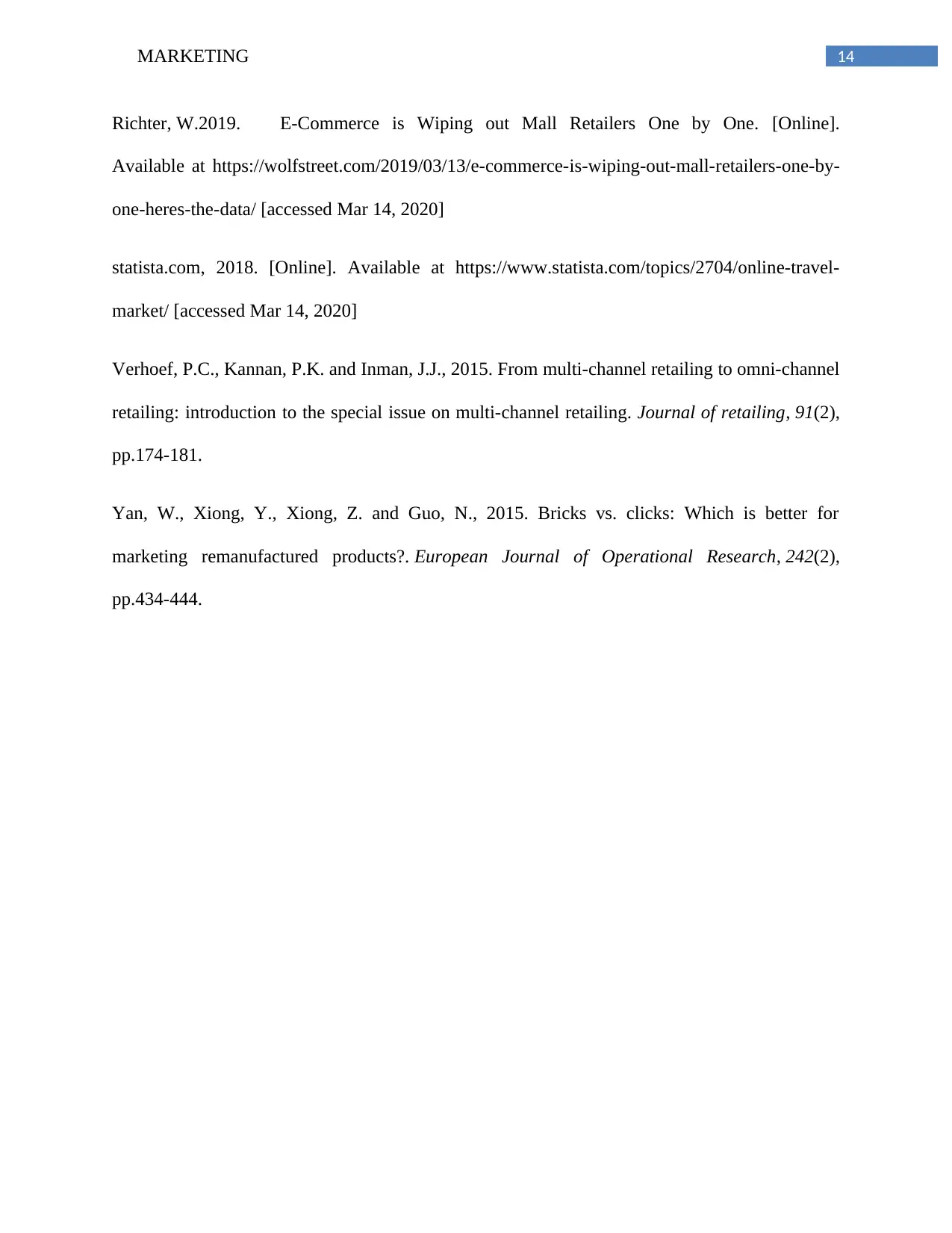
14MARKETING
Richter, W.2019. E-Commerce is Wiping out Mall Retailers One by One. [Online].
Available at https://wolfstreet.com/2019/03/13/e-commerce-is-wiping-out-mall-retailers-one-by-
one-heres-the-data/ [accessed Mar 14, 2020]
statista.com, 2018. [Online]. Available at https://www.statista.com/topics/2704/online-travel-
market/ [accessed Mar 14, 2020]
Verhoef, P.C., Kannan, P.K. and Inman, J.J., 2015. From multi-channel retailing to omni-channel
retailing: introduction to the special issue on multi-channel retailing. Journal of retailing, 91(2),
pp.174-181.
Yan, W., Xiong, Y., Xiong, Z. and Guo, N., 2015. Bricks vs. clicks: Which is better for
marketing remanufactured products?. European Journal of Operational Research, 242(2),
pp.434-444.
Richter, W.2019. E-Commerce is Wiping out Mall Retailers One by One. [Online].
Available at https://wolfstreet.com/2019/03/13/e-commerce-is-wiping-out-mall-retailers-one-by-
one-heres-the-data/ [accessed Mar 14, 2020]
statista.com, 2018. [Online]. Available at https://www.statista.com/topics/2704/online-travel-
market/ [accessed Mar 14, 2020]
Verhoef, P.C., Kannan, P.K. and Inman, J.J., 2015. From multi-channel retailing to omni-channel
retailing: introduction to the special issue on multi-channel retailing. Journal of retailing, 91(2),
pp.174-181.
Yan, W., Xiong, Y., Xiong, Z. and Guo, N., 2015. Bricks vs. clicks: Which is better for
marketing remanufactured products?. European Journal of Operational Research, 242(2),
pp.434-444.

15MARKETING
1 out of 16
Related Documents
Your All-in-One AI-Powered Toolkit for Academic Success.
+13062052269
info@desklib.com
Available 24*7 on WhatsApp / Email
![[object Object]](/_next/static/media/star-bottom.7253800d.svg)
Unlock your academic potential
© 2024 | Zucol Services PVT LTD | All rights reserved.





